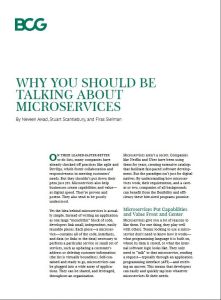Join getAbstract to access the summary!

Join getAbstract to access the summary!
Neveen Awad, Stuart Scantlebury and Firas Sleiman
Why You Should Be Talking About Microservices
Boston Consulting Group, 2019
What's inside?
Learn how microservices can complement agile software development strategies.
Recommendation
As organizations strive for greater agility, their software development teams often turn to microservices for flexibility and efficiency. Amazon, PayPal and Netflix, among many tech supergiants, have been leaving their monolithic structures behind and are moving to microservices architectures. For executives looking toward their own transition, a team at the Boston Consulting Group offers a clear, authoritative introduction to the technology.
Summary
About the Authors
Neveen Awad is a managing director and partner at Boston Consulting Group, and Stuart Scantlebury is a senior advisor. Firas Sleiman is an associate director and architecture practice lead at BCG Platinion.


















Comment on this summary